Energy and Spectrally Efficient Modulation Scheme for IoT Applications
Abstract
1. Introduction
- The OSP-MSK Modulation/Demodulation Scheme: The OSP-MSK is proposed as a low-power and low-cost modulation scheme. The OSP-MSK relaxes both the power budget and the hardware complexity by using nonlinear PAs at the TX side and by deploying a low-resolution one-bit ADC at the RX side. Furthermore, the OSP-MSK achieves a higher spectral efficiency than the recent MIMO-CEM system by increasing the number of bits per symbol without additional bandwidth.
- OSP-MSK Performance Analysis: Firstly, a generic closed form expression for assessing the average bit error rate (ABER) performance of the proposed OSP-MSK modulation over an additive white Gaussian noise (AWGN) is presented thoroughly. Afterwards, this expression is used to derive closed-form expressions for the ABER performance of the OSP-MSK over the generalized Rayleigh and Nakagami-m fading channels.
- OSP-MSK Bandwidth Utilization: The bandwidth utilization of the OSP-MSK is evaluated by deriving a closed form expression of its power spectral density (PSD). This PSD is used to assess the ability of the OSP-MSK to boost the spectral efficiency compared to the MIMO-CEM system.
2. The OSP-MSK Modulation System Model
3. OSP-MSK Performance Analysis
3.1. OSP-MSK ABER Perfrmance
3.1.1. Rayleigh Fading Channel
3.1.2. Nakagami-M Fading Channel
3.2. OSP-MSK Power Spectral Density
4. Simulation Results
4.1. ABER Performance
4.2. PSD Perfomance
5. Conclusions
Author Contributions
Funding
Acknowledgments
Conflicts of Interest
Appendix A
Appendix B
Appendix C
References
- Atzori, L.; Iera, A.; Morabito, G. The internet of things: A survey. Comput. Netw. 2010, 54, 2787–2805. [Google Scholar] [CrossRef]
- Vermesan, O.; Friess, P.; Guillemin, P.; Gusmeroli, S.; Sundmaeker, H.; Bassi, A.; Jubert, I.S.; Mazura, M.; Harrison, M.; Eisenhauer, M.; et al. Internet of things strategic research roadmap. Internet Things-Glob. Technol. Soc. Trends 2011, 1, 9–52. [Google Scholar]
- Gokceoglu, A.; Björnson, E.; Larsson, E.G.; Valkama, M. Spatio-temporal waveform design for multiuser massive MIMO downlink with 1-bit receivers. IEEE J. Sel. Top. Signal Process. 2017, 11, 347–362. [Google Scholar] [CrossRef]
- Zanella, A.; Bui, N.; Castellani, A.; Vangelista, L.; Zorzi, M. Internet of things for smart cities. IEEE Internet Things J. 2014, 1, 22–32. [Google Scholar] [CrossRef]
- Lin, J.; Yu, W.; Zhang, N.; Yang, X.; Zhang, H.; Zhao, W. A survey on internet of things: Architecture, enabling technologies, security and privacy, and applications. IEEE Internet Things J. 2017, 4, 1125–1142. [Google Scholar] [CrossRef]
- Ejaz, W.; Anpalagan, A.; Imran, M.A.; Jo, M.; Naeem, M.; Qaisar, S.B.; Wang, W. Internet of Things (IoT) in 5G wireless communications. IEEE Access 2016, 4, 10310–10314. [Google Scholar] [CrossRef]
- Larsson, E.G.; Edfors, O.; Tufvesson, F.; Marzetta, T.L. Massive MIMO for next generation wireless systems. IEEE Commun. Mag. 2014, 52, 186–195. [Google Scholar] [CrossRef]
- Zheng, K.; Zhao, L.; Mei, J.; Shao, B.; Xiang, W.; Hanzo, L. Survey of large-scale MIMO systems. IEEE Commun. Surv. Tutor. 2015, 17, 1738–1760. [Google Scholar] [CrossRef]
- Zhu, J.; Xu, W.; Wang, N. Secure massive MIMO systems with limited RF chains. IEEE Trans. Veh. Technol. 2017, 66, 5455–5460. [Google Scholar] [CrossRef]
- Prasad, K.S.V.; Hossain, E.; Bhargava, V.K. Energy efficiency in massive MIMO-based 5G networks: Opportunities and challenges. IEEE Wirel. Commun. 2017, 24, 86–94. [Google Scholar] [CrossRef]
- Risi, C.; Persson, D.; Larsson, E.G. Massive MIMO with 1-bit ADC. Available online: http://arxiv.org/abs/1404.7736 (accessed on 1 September 2018).
- Jacobsson, S.; Durisi, G.; Coldrey, M.; Gustavsson, U.; Studer, C. One-bit massive MIMO: Channel estimation and high-order modulations. In Proceedings of the IEEE International Conference on Communication Workshop (ICCW), London, UK, 8–12 June 2015; pp. 1304–1309. [Google Scholar]
- Li, Y.; Tao, C.; Seco-Granados, G.; Mezghani, A.; Swindlehurst, A.L.; Liu, L. Channel estimation and performance analysis of one-bit massive MIMO systems. IEEE Trans. Signal Process. 2017, 65, 4075–4089. [Google Scholar] [CrossRef]
- Choi, J.; Mo, J.; Heath, R.W. Near maximum-likelihood detector and channel estimator for uplink multiuser massive MIMO systems with one-bit ADCs. IEEE Trans. Commun. 2016, 64, 2005–2018. [Google Scholar] [CrossRef]
- Jacobsson, S.; Durisi, G.; Coldrey, M.; Gustavsson, U.; Studer, C. Throughput analysis of massive MIMO uplink with low-resolution ADCs. IEEE Trans. Wirel. Commun. 2017, 16, 4038–4051. [Google Scholar] [CrossRef]
- Wen, C.-K.; Wang, C.-J.; Jin, S.; Wong, K.-K.; Ting, P. Bayes-optimal joint channel-and-data estimation for massive MIMO with low-precision ADCs. IEEE Trans. Signal Process. 2016, 64, 2541–2556. [Google Scholar] [CrossRef]
- Wang, S.; Li, Y.; Wang, J. Multiuser detection in massive spatial modulation MIMO with low-resolution ADCs. IEEE Trans. Wirel. Commun. 2015, 14, 2156–2168. [Google Scholar] [CrossRef]
- Studer, C.; Durisi, G. Quantized massive mu-mimo-ofdm uplink. IEEE Trans. Commun. 2016, 64, 2387–2399. [Google Scholar] [CrossRef]
- Mollén, C.; Choi, J.; Larsson, E.G.; Heath, R.W., Jr. Uplink Performance of Wideband Massive MIMO with One-Bit ADCs. IEEE Trans. Wirel. Commun. 2017, 16, 87–100. [Google Scholar] [CrossRef]
- Zhang, J.; Dai, L.; Sun, S.; Wang, Z. On the Spectral Efficiency of Massive MIMO Systems with Low-Resolution ADCs. IEEE Commun. Lett. 2016, 20, 842–845. [Google Scholar] [CrossRef]
- Muta, O. Study on MIMO Wireless Transmission with Constant Envelope Modulation and a Low-Resolution ADC; IEICE Technical Report; IEICE: Tokyo, Japan, 2010; pp. 157–162. [Google Scholar]
- Mohamed, E.M.; Muta, O.; Furukawa, H. Adaptive channel estimation for MIMO-constant envelope modulation. IEICE Trans. Commun. 2012, 95, 2393–2404. [Google Scholar] [CrossRef]
- Mohamed, E.M.; Muta, O.; Furukawa, H. Static and dynamic channel estimation techniques for MIMO-constant envelope modulation. In Proceedings of the IEEE GLOBECOM Workshops (GC Wkshps), Houston, TX, USA, 5–9 December 2011; pp. 549–554. [Google Scholar]
- Mohamed, E.M.; Muta, O.; Furukawa, H. Channel estimation technique for MIMO-constant envelope modulation. In Proceedings of the International Wireless Communications and Mobile Computing Conference (IWCMC), Istanbul, Turkey, 4–8 July 2011; pp. 1433–1440. [Google Scholar]
- Hussein, S.; Hussein, H.S.; Mohamed, E.M. Low complexity channel estimation technique for 1-bit ADC MIMO-constant envelope modulation using compressive sensing. In Proceedings of the IEEE Asia Pacific Microwave Conference (APMC), Kuala Lumpar, Malaysia, 13–16 November 2017; pp. 889–893. [Google Scholar]
- Elsayed, M.; Hussein, H.S.; Mohamed, U.S. Higher order modulation scheme for the 1-bit ADC MIMO-constant envelope modulation. In Proceedings of the IEEE Asia Pacific Microwave Conference (APMC), Kuala Lumpar, Malaysia, 13–16 November 2017; pp. 894–898. [Google Scholar]
- Ta, T.T.; Oshima, S.; Oguma, H.; Kameda, S.; Takagi, T.; Tsubouchi, K. A constant envelope modulation method using orthogonal frequency allocated multi-carrier MSK for broadband wireless system. In Proceedings of the Third International Conference on Communications and Electronics (ICCE), Nha Trang, Vietnam, 11–13 August 2010; pp. 253–257. [Google Scholar]
- Simon, M.K.; Alouini, M.-S. Digital Communication over Fading Channels; John Wiley & Sons: Hoboken, NJ, USA, 2005; Volume 95. [Google Scholar]
- Gradshteyn, I.S.; Ryzhik, I.M. Table of Integrals, Series, and Products; Academic Press: Cambridge, MA, USA, 2014. [Google Scholar]
- Guimaraes, D.A. Digital Transmission: A Simulation-Aided Introduction with VisSim/Comm; Springer Science & Business Media: New York, NY, USA, 2010. [Google Scholar]
- Sklar, B. Digital Communications; Prentice Hall: Upper Saddle River, NJ, USA, 2001; Volume 2. [Google Scholar]
- Han, J.S.; Kim, M.J. Quadrature multiplexed Gaussian minimum shift keying. In Proceedings of the International Conference on ICT Convergence (ICTC), Jeju, Korea, 15–17 October 2012; pp. 610–611. [Google Scholar]
- Han, J.S.; Kim, M.J. Bit error probability and power spectral density of quadrature multiplexed GMSK. In Proceedings of the International Conference on ICT Convergence (ICTC), Jeju, Korea, 14–16 October 2013; pp. 223–227. [Google Scholar]
- Proakis, J.G. Digital Communications; McGraw-Hill: New York, NY, USA, 1995. [Google Scholar]
- Orovic, I.; Zaric, N.; Stankovic, S.; Radusinovic, I.; Veljovic, Z. Analysis of power consumption in OFDM systems. J. Green Eng. 2011, 8, 477–489. [Google Scholar]
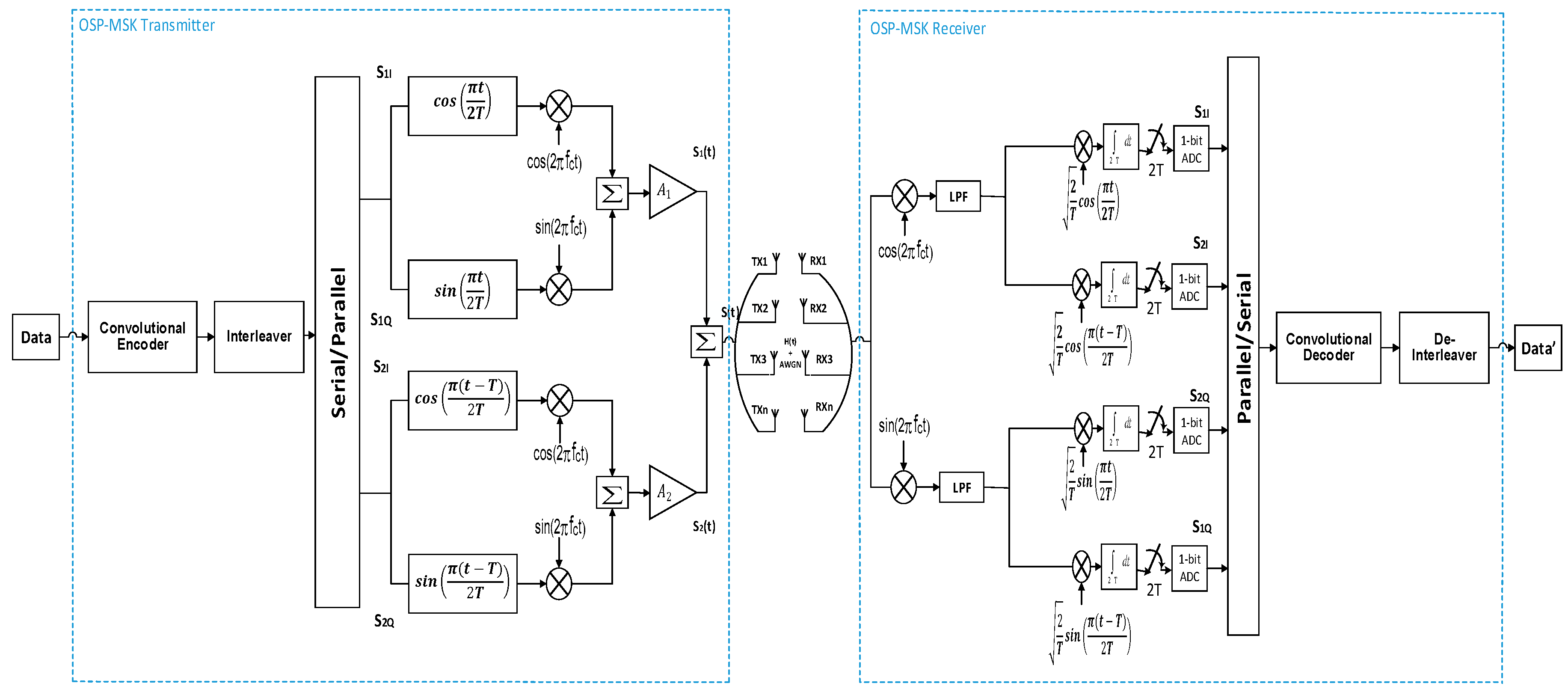


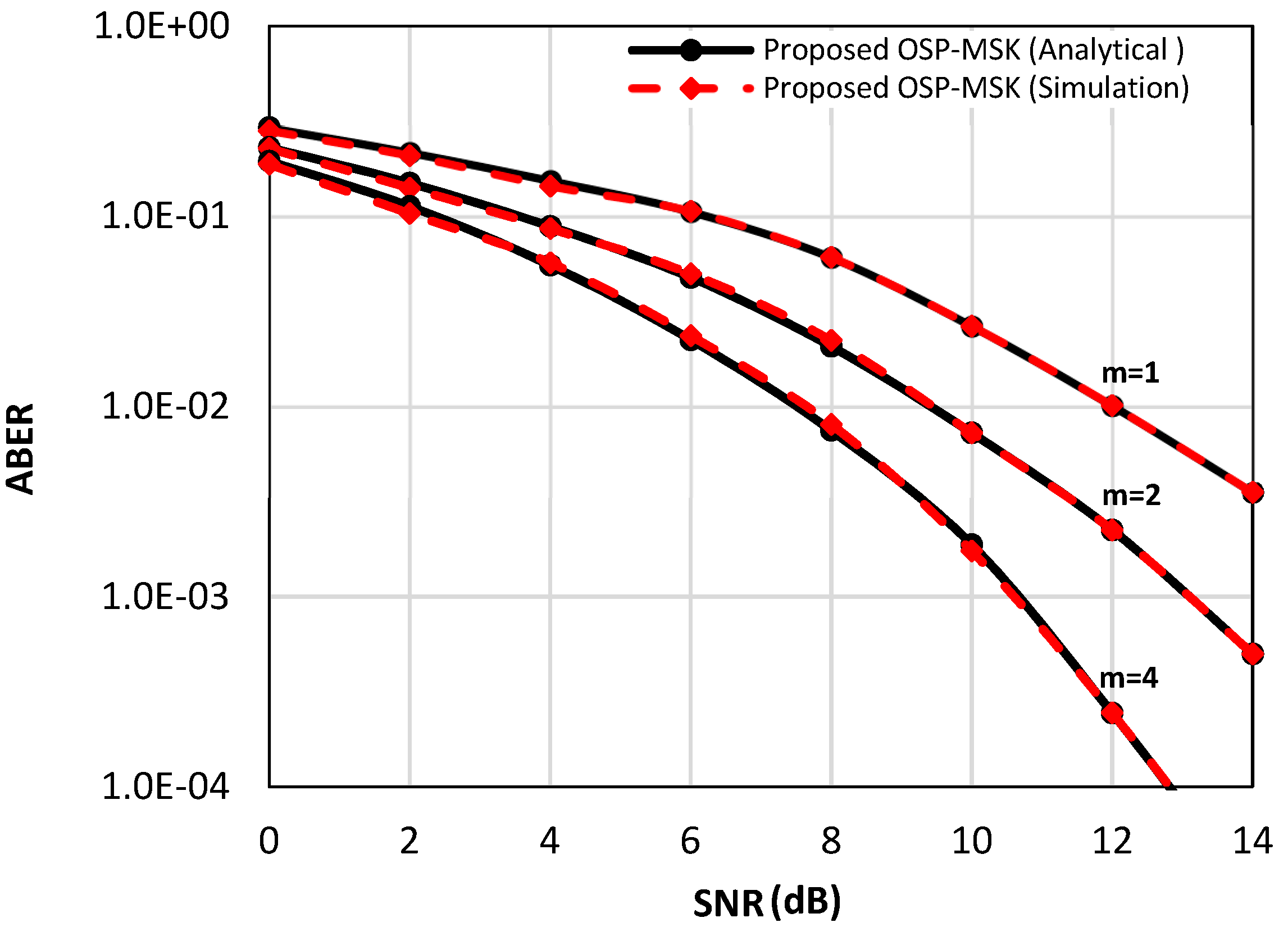
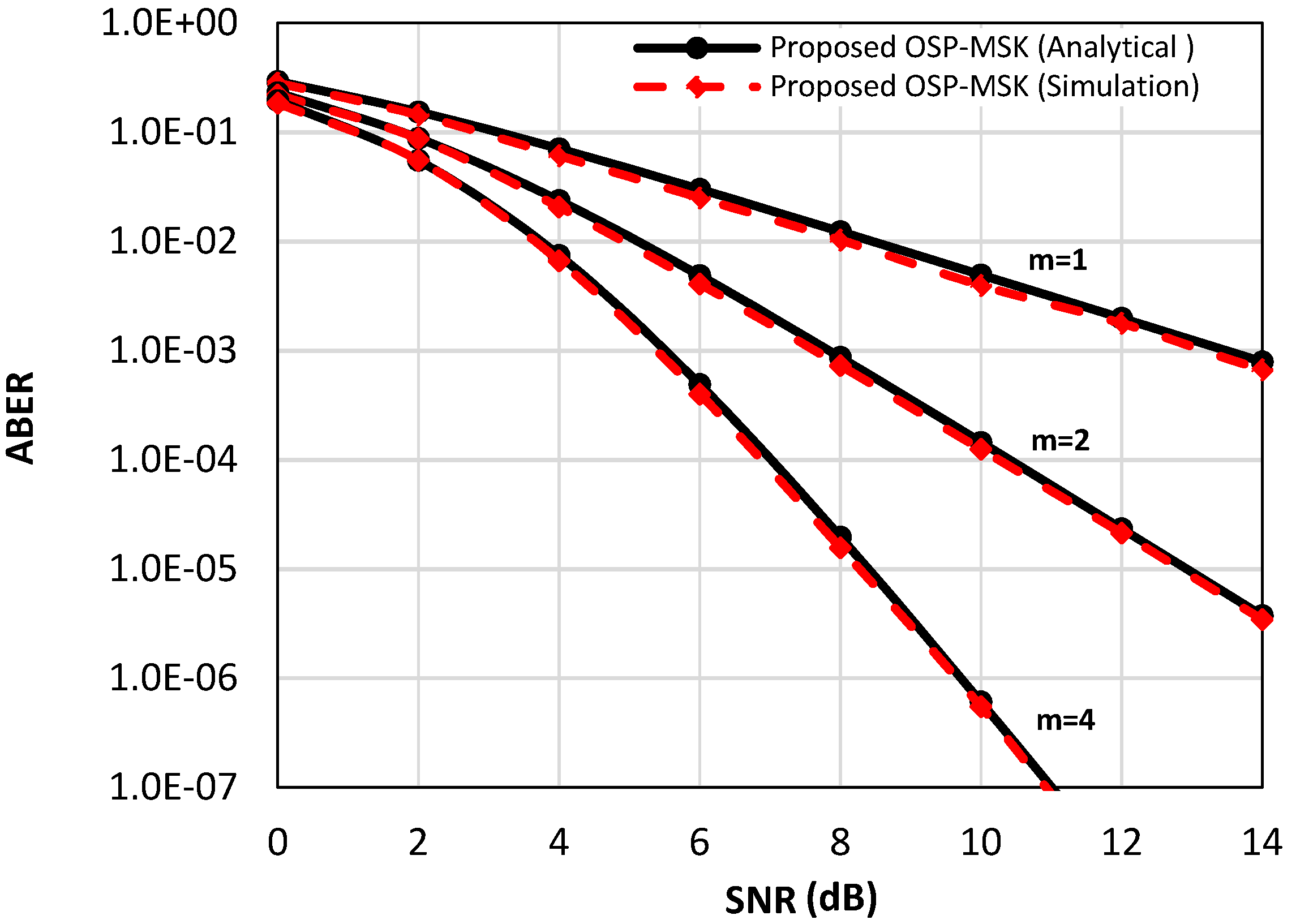
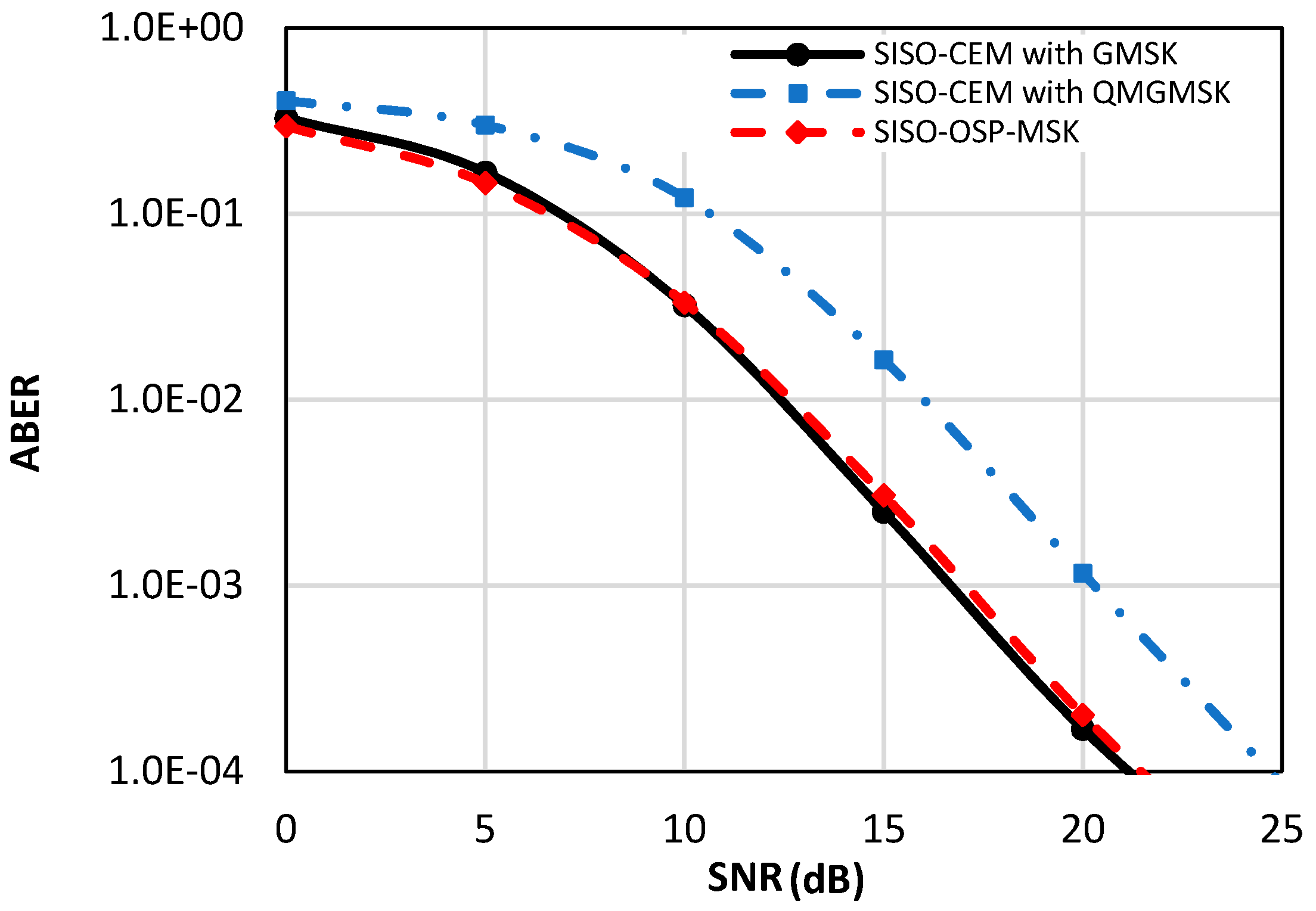
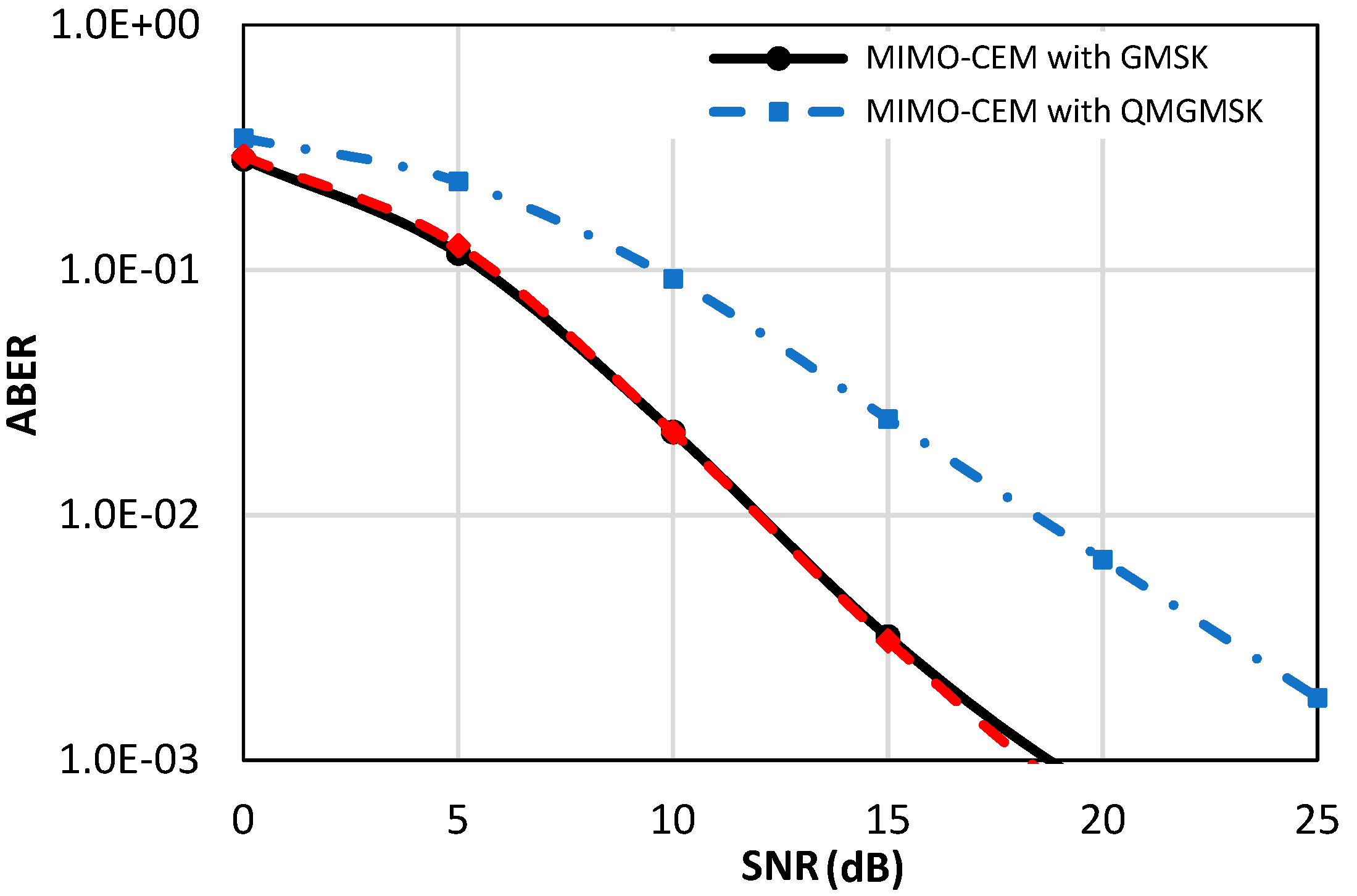
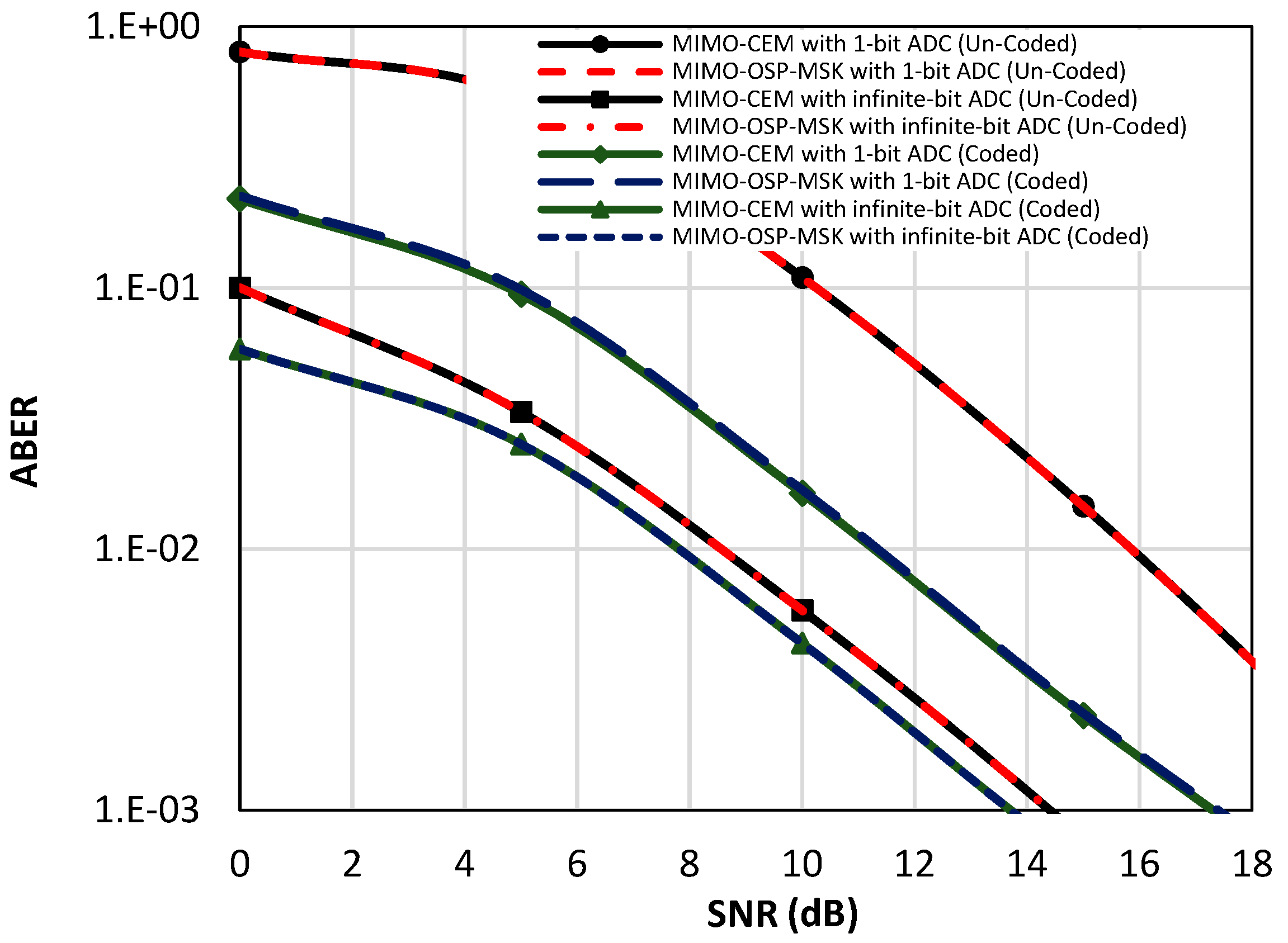
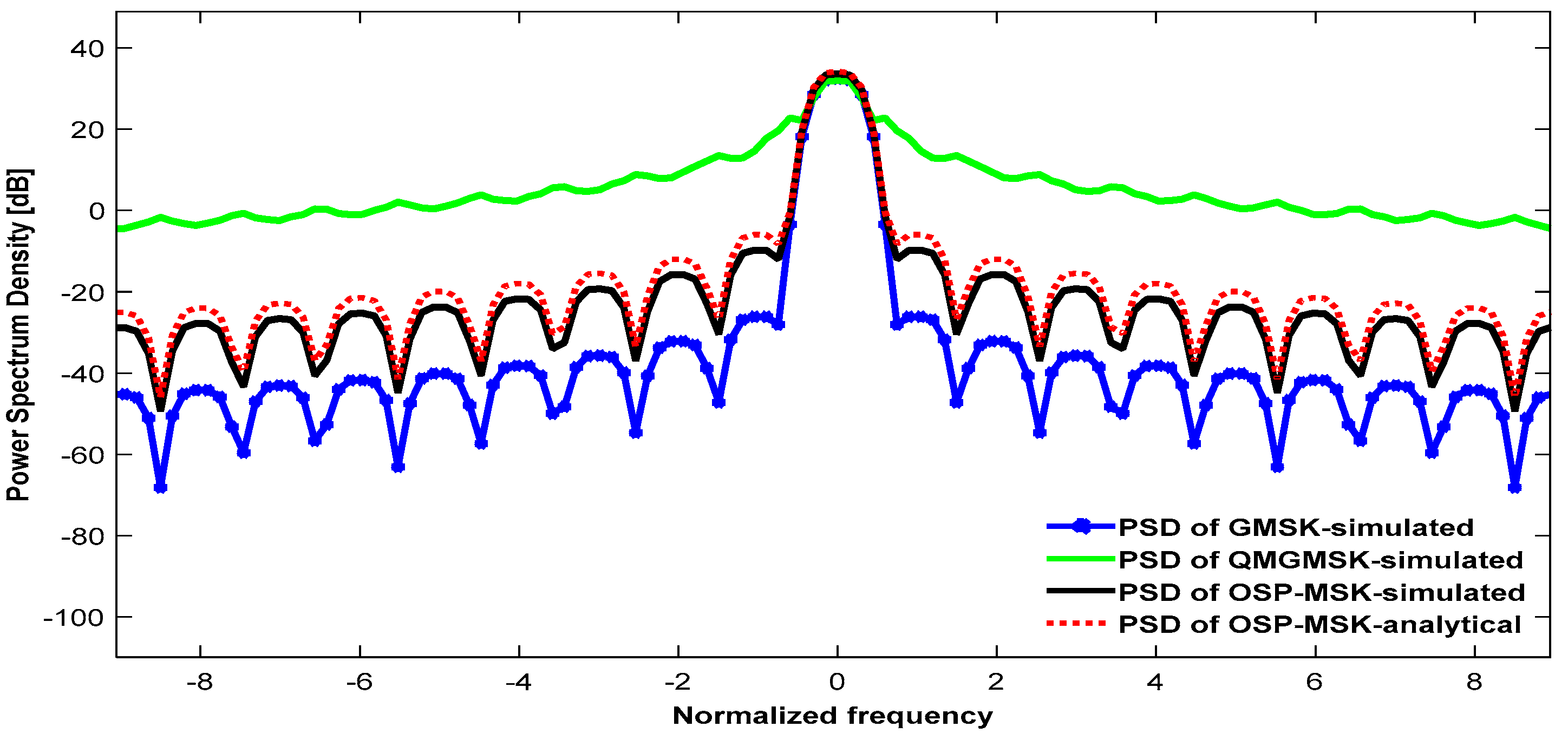
| Parameter | Value |
|---|---|
| ADC sampling rate | 16 fs |
| Number of bits/packets | Eight bits |
| MLSE equalizer size | 256 states |
| Band pass filter (BPF) | Six-order Butterworth BPF |
| BPF bandwidth (BW) | BW = 0.6 |
| ADC resolution | One-bit ADC |
| Channel encoder | Convolutional Encoder |
| Channel encoder’s constraint length | Constrain length = seven |
| Channel encoder’s rate | rate = ½ |
| Channel encoder’s polynomials | g0 = x7 + x2 + x1 and g1 = x7. |
| Channel decoder | Hard decision Viterbi decoder |
| Number of transmit antennas | Two antennas |
| Number of receive antennas | Two antennas |
© 2018 by the authors. Licensee MDPI, Basel, Switzerland. This article is an open access article distributed under the terms and conditions of the Creative Commons Attribution (CC BY) license (http://creativecommons.org/licenses/by/4.0/).
Share and Cite
Hussein, H.S.; Elsayed, M.; Fakhry, M.; Sayed Mohamed, U. Energy and Spectrally Efficient Modulation Scheme for IoT Applications. Sensors 2018, 18, 4382. https://doi.org/10.3390/s18124382
Hussein HS, Elsayed M, Fakhry M, Sayed Mohamed U. Energy and Spectrally Efficient Modulation Scheme for IoT Applications. Sensors. 2018; 18(12):4382. https://doi.org/10.3390/s18124382
Chicago/Turabian StyleHussein, Hany S., Mohamed Elsayed, Mahmoud Fakhry, and Usama Sayed Mohamed. 2018. "Energy and Spectrally Efficient Modulation Scheme for IoT Applications" Sensors 18, no. 12: 4382. https://doi.org/10.3390/s18124382
APA StyleHussein, H. S., Elsayed, M., Fakhry, M., & Sayed Mohamed, U. (2018). Energy and Spectrally Efficient Modulation Scheme for IoT Applications. Sensors, 18(12), 4382. https://doi.org/10.3390/s18124382





